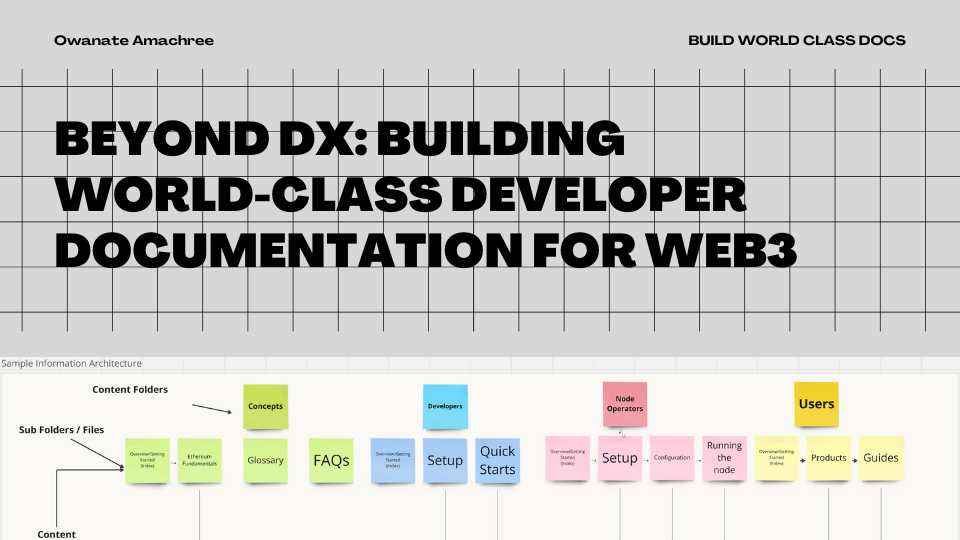User Research Methods to Boost Your Information Architecture Design
 Owanate Amachree
Owanate AmachreeTable of contents

To effectively improve your documentation and drive developer adoption, you need to understand:
Developer Journey: How do developers and users discover your documentation? What challenges do they face when finding the content? How do you tailor/map the content based on the user journeys?
Decision-Making Factors: What motivates developers to choose your platform? It could be documentation with straightforward guides on getting started—or juicy opportunities available within your ecosystem, such as grants programs, ambassador programs, hackathons, etc.
Previously, we explored the Web3 landscape, challenges and differences between Web3 Documentation and Traditional Documentation. See Exploring the Web3 Documentation: Key Challenges and Growth Opportunities.
This section will explore how to conduct user research for documentation that informs your information architecture design. We will also learn how to tailor content based on developer journeys and experience levels.
User research is the first step to understanding user needs, pain points, and expectations. Some of these methods usually include surveys, interviews, and usability testing. This is critical to solving developers' challenges. Adopting a structured approach will lead to insightful discoveries and insights into what features developers prioritise.
During the research phase, aim to discover the answers to these questions:
Who are the users of your platform?
Who are your developers? (segments and personas)
What are their pain points?
What are their developer journeys?
What are their expectations at each stage of the developer journey?
What content do your users expect to see or interact with based on their journeys?
How do I group the content to solve the needs of different audiences? What is my information architecture?
How do you know what content needs to be moved, audited, added, reviewed, or no longer used?
How do you keep track of the content and taxonomy to ensure it aligns with the user's expectations?
How do you conduct taxonomy / URL planning?
If you already use docs as code, find out if the current platform works or if you need to change to a more community-friendly platform.
What features do developers enjoy using?
Time to read
Edit this page,
Authored by, etc
Is the tool free or paid? Closed source? Paid open source?
Does the platform have a robust community and components that keep it in sync with current documentation features?
Can the development be handled in-house or contracted to an agency if migrating to a new platform?
What’s the budget?
What’s the timeline for the project's delivery?
What are the trade-offs? SEO, impact on traffic, broken links, accessibility across different platforms and users (Mobile, Web, etc.)
What priority features must be shipped, and what secondary features are required?
Do you need to add localisation? What are the targeted countries?
Night mode toggle
Code samples and callouts
Etc
How does the project contribute to overall organisation goals and vision
How can developer activity be measured and tracked using the documentation?
How do you ship this to the market and get feedback?
The research should address these, among other questions. The docs survey should also be designed to ask the developer some of these questions.
Now, let’s figure out an answer to some of these questions…
Before going ahead, let’s define some essential terms:
Taxonomy: A content taxonomy is a scheme of classification used to organize and categorize content.
Information Architecture:
Docs as Code: As the name implies, it refers to treating technical documentation like code; this involves using tools and techniques like version control (GitHub), automation (CICD) with static site generators (SSG) and more.
Platform: Refers to the documentation being considered or currently in use
User Persona and Journey Mapping
User research and journey mapping should be carried out on the platform level and for the documentation. Determine who your users are and what business model you operate under. This could be a B2B, B2C, or B2b2C model; knowing the ideal customer on a platform level allows for easy identification of the ideal customers and what content should serve them.
One way to achieve this is by building a developer journey map for each persona using tools like Miro or Notion.
In the image below, there are five stages of journey mapping: discover, Evaluate, Learn, Build and Scale. “The Developer Journey Map is a visualisation that identifies the path a developer follows and experiences.
As users move left to right across the stages, their interaction with your brand, team, and product increases. It’s one of the most valuable tools in Developer Relations. It helps you think holistically about the experience from the developers’ perspective while providing an efficient guide. “Read more about the developer journey map on DevRel.Agency.
Next, we will use the strategies above to create a sample Information Architecture for a typical Web3 Docs Platform.
Resources
Huge thanks to Brendan Graetz for the review and feedback.
Subscribe to my newsletter
Read articles from Owanate Amachree directly inside your inbox. Subscribe to the newsletter, and don't miss out.
Written by

Owanate Amachree
Owanate Amachree
I’m a lead technical writer with over four years of experience helping global blockchain companies drive product adoption. Through high-quality product documentation, guides, and articles, I have empowered over 7,000 developers, users, and enterprise businesses to engage effectively with blockchain technologies. Currently serving as a Lead Technical Writer at RootstockLabs, I have authored and published over 50 guides and tutorials, significantly improving developer onboarding and user experience.